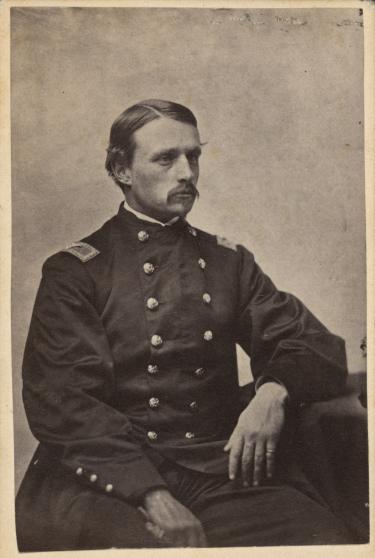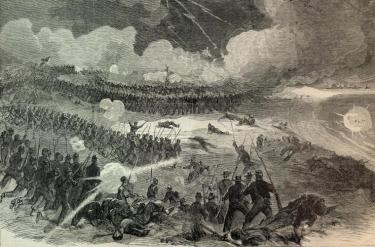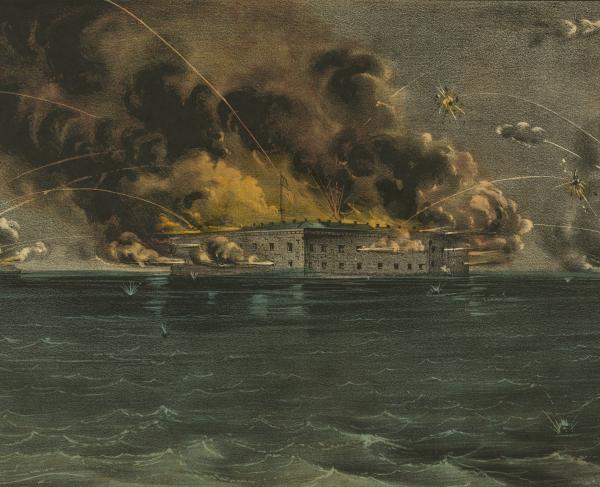
The 54th Massachusetts was one of the first United States military regiment comprised of African American soldiers in the Union during the Civil War. After President Abraham Lincoln’s issuance of the Emancipation Proclamation, states were officially allowed to create all Black regiments. Massachusetts was the first state to begin the formation of these newly authorized Black regiments. Massachusetts Governor John A. Andrew called for men to lead this experimental unit who were, “young men of military experience, of firm anti-slavery principles, ambitious, superior to a vulgar contempt for color, and have faith in the capacity of colored men for military service.” This call perhaps produced more active abolitionists for the 54th and her sister regiment the 55th than any other regiment in the North.

The formation of the 54th Massachusetts was closely watched by the public and politicians within the Union. Massachusetts governor John A. Andrew spearheaded the effort of the creation of this new unit. Many in the north had the perception that the war was a “white man’s war” and that freed African Americans should not serve in any fighting roles whatsoever. Many also believed that the men would lack discipline and would easily waiver in battle. In time, however, these misconceptions would drastically change. The man to lead the 54th was Robert Gould Shaw. Shaw was a member of the 2nd Massachusetts and had already seen combat and was previously wounded at the Battle of Antietam. In February of 1863, recruiting for the 54th began and Shaw was promoted to colonel of the regiment. By May of 1863, the regiment had filled to one thousand men and consisted of men from not only Massachusetts, but from New York, Pennsylvania, and other northern cities and states. Of those one thousand were two of Frederick Douglass’ sons Lewis and Charles Douglass, as well as the first African American recipient of the Medal of Honor William Carney. On May 28, 1863, the men were ready to depart on their journey. The 54th marched through Boston with a crowd of twenty thousand cheering them on to their departure. The 54th loaded onto the Demolay and ventured south.
The 54th Massachusetts arrived in South Carolina under the command of James Montgomery, an Ohio native that led the 2nd South Carolina Volunteers – a freedman’s regiment. Shaw and Montgomery led a raid on the small town of Darien, Georgia in which Montgomery instructed the 2nd Carolina and the 54th Massachusetts to loot the town and subsequently set fire to the town. Shaw opposed Montgomery but complied with Montgomery’s orders to avoid risking a court-martial. Two months later, on July 16, 1863, the regiment’s first major engagement of the war took place. Located on James Island outside of Charleston, South Carolina, the Battle of Grimball’s Landing gave a chance for the regiment to prove themselves in battle. The 54th successfully stopped a Confederate advance meant for the 10th Connecticut that was retreating. Repeatedly, the 54th Massachusetts repelled Confederate advances until the 10th Connecticut could withdraw from the area. After the smoke settled, the 54th had amassed 43 casualties, while the Confederates were pushed back.

The 54th had proven themselves in battle, and the regiment’s morale was high. The anticipation of another engagement was itching in the 54th's collars. Just two days later, on July 18, 1863, the 54th was in the vanguard of the assault on Fort Wagner, overlooking Charleston Harbor. The battle was the bloodiest battle that the 54th witnessed, with a total of 270 casualties out of the 600 men in the regiment during the battle. Colonel Robert Shaw was killed during the engagement, leaving Edward Hallowell in charge of the 54th. Union forces were unable to take Fort Wagner by frontal assault, however, the 54th Massachusetts was noted for their bravery and valor in battle. The 54th's actions displayed in battle paved the way for the Union to begin requisitioning more Black regiments to contribute in the war effort.
In February of 1864, the 54th fought at the Battle of Olustee in Florida. The 54th was responsible for covering the retreating Union troops fleeing to Jacksonville, Florida after an intense battle. The 54th, along with the 35th United States Colored Troops, repulsed the Confederate advance successfully.

The 54th Massachusetts fought up until mid-April 1865 at the Battle of Boykin’s Mill in South Carolina. The 54th engaged the highly outnumbered Confederate troops in a successful attack that left two men killed and thirteen wounded. One of the killed men was First Lieutenant E.L. Stevens, who was the last Union officer to be killed in the Civil War. Boykin’s Mill also is noted for being the last battle in South Carolina, and one of the final battles of the war. Following the war, the 54th Massachusetts was mustered out of service on August 20, 1865, in Mount Pleasant, South Carolina.
After the war, the 54th's actions were memorialized by Augustus Saint-Gauden's bronze monument located just outside of the Massachusetts State House in the Boston Commons. The monument was created under the supervision of Robert Shaw’s surviving family, and the monument features the famed colonel with his soldiers. On May 23, 1900, Sergeant William Carney was awarded the Medal of Honor, being the first African American to receive the medal for his actions during the Battle of Fort Wagner. (Robert Blake was the first African American to physically receive the Medal of Honor as his was issued in 1864, Carney is the first African American to perform the action that earned him the Medal of Honor.) Carney was severely wounded while serving as color bearer after the previous color bearer fell in battle. He explained to the veterans of the 54th, “Boys, I did but my duty; the dear old flag never touched the ground.”
The 54th Massachusetts defied the odds put up against them in a time of uncertainty. Becoming one of the first all-Black soldier regiments in the history of the United States, the 54th proved themselves in battle and showed the country that had discounted them from the start that they were formidable in combat. Despite scrutiny by the Union, the men of the 54th were accredited with turning the tide of war due to the influx of Black regiments that were mustered into service by President Abraham Lincoln.
Further Reading
- Thunder at the Gates: The Black Civil War Regiments That Redeemed America By: Douglas R. Egerton
- A Brave Black Regiment: The History of the Fifty-Fourth Regiment of the Massachusetts Volunteer Infantry 1863-1865 By: Captain Luis F. Emilio


